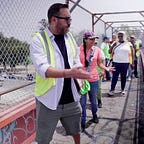I Recognize This Bureaucracy
It almost killed Embedded Planning.
At the Metropolitan Museum of Art, I came across a George Tooker painting that haunted me. It was eerie, upsetting, familiar, and motivating at once. And it reinforced the message of my Embedded Planning talk for Columbia GSAPP’s Lectures in Planning Series.
Government Bureau (1956) places you in a drab and depressing municipal office. Faceless community members wait in long lines for service. Anonymous bureaucrats sit behind desks concealed except for cutouts revealing blank stares through dead eyes. Nobody looks well. This workplace is cold, rigid, uninspiring. In the air, misery.
I lost track of time staring, enthralled, at this work hung in a quiet corner of the gallery. My wife was at my side. At some point she walked away. I didn’t even notice.
. . . I recognized this place.
As I described in “Embedded Planning Is Worth The Struggle,” this was the ethos of my final years at a large municipal bureaucracy in Southern California. It suffocated me, almost killed Embedded Planning. So I left.¹
It doesn’t have to be this way.
An antidote to this dread is to deinstitutionalize planning practice. Get out of your stuffy office. Put feet on the ground. Be present. Move with intention. Meet people where they are. Take planning to the streets.
We have precedent.
In act five of my talk, I quote John Friedmann’s 1973 book Retracking America: A Theory of Transactive Planning:
“Our inherited notions of planning are dead. We are thus constrained to reconsider what we need and on the basis of this need to rethink planning from the start.²
The utopian thrust of planning runs counter to the inherent conservatism of mature bureaucracies. To maintain this utopian thrust…, planning may have to be taken outside the constraining framework of bureaucratic organizations.” ³
This is Embedded Planning praxis!
It’s our approach to planning conducted outside of constraining and sometimes hostile bureaucracies. Street-level planning is how we co-create a better world with community members. Face-to-face relationship building in their spaces brings opportunities for what the planning process lacks: long-term partnerships and joy.
An early version of this story appeared on my Instagram on December 4, 2022.
End notes
¹ There’s more to it. I tell the full story in “Embedded Planning Is Worth The Struggle.” Where are we doing this in-person talk next? Hit me up.
² John Friedmann, Retracking America: A Theory of Transactive Planning (Garden City, New York: Anchor Press/Doubleday, 1973), Preface xiii.
³ Ibid, 7. Emphasis added.
